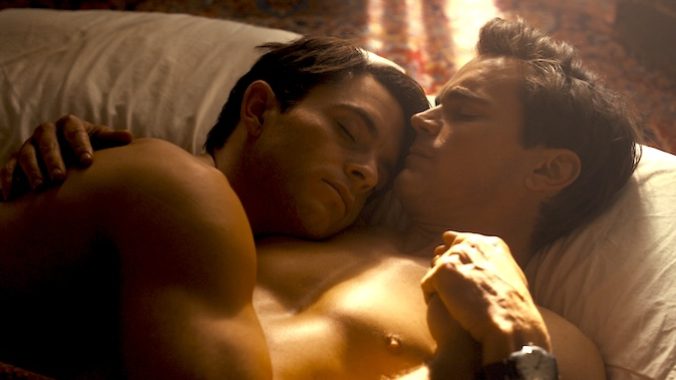Sex Scene Discourse Is No Match for Fellow Travelers
Photo Courtesy of Showtime
Every month, it seems like sex scenes become a source of discourse amongst critics and various stan accounts alike. From new stats citing that young people don’t want to see sex scenes in the programs they watch, to fantastic articles examining the sparse amount of scenes released this year, the conversation seems never ending. While the discourse assumes that sex is dominating film and television, that can’t be farther from the truth.
The minimization of sex scenes raises a broader concern of who is allowed to have sex on screen. More often than not, these scenes are relegated to showcasing sex between heterosexual couples, with gay characters left to collect dust like collectables left on a shelf. Gay representation in media is often praised, but when characters are simply added to represent queerness, rather than show it, representation itself is not enough. It seems that, in regards to sex scenes, gay characters are almost as forgotten as the scenes themselves are, but there’s one new series that is trying to change that.
Showtime’s Fellow Travelers was released earlier this month to little fanfare. While lovers of the original novel of the same name tuned in, it seemed like it was going to pass by with little attention, which is the case for many shows in such an oversaturated market. With its first episode, the miniseries promised a decades-spanning love story between two characters played by actors with a chemistry so stunning it takes your breath away. But, most importantly, Fellow Travelers offered its viewers sex scenes that rival even the most risqué erotic thrillers of the 1990s.
In Fellow Travelers, the sex scenes are intrinsic to understanding not only the relationship between Hawk (Matt Bomer) and Tim (Jonathan Bailey), but understanding the two of them as singular people. For Hawk, sex is integral to his very being, and he is almost unable to exist without it. Before he meets Tim, sex is used as a means to assert some dominance over a life that feels like it is not his own. He goes through his days knowing that he will eventually have to marry a woman and disguise his sexuality, so sex remains the sole aspect of his true life that he does not have to get rid of. He wields his body like a weapon, engaging in rough sex with random men as a means to feel control, even for the briefest moment.
Tim, on the other hand, views sex as a means of connection. Hawk is elusive even once his relationship with Tim becomes more serious, and it feels as if the only time Hawk is truly his unbridled self is when they’re having sex. Tim knows that this is when Hawk is the most unabashed, and in turn, uses it to get what he wants. In an interview with the LA Times, director Daniel Minahan stated that “it’s always important to me that sex scenes aren’t gratuitous, that they have a beginning, middle, and an end. And they tell a story but they also reveal aspects of the characters.” While they are highly erotic, the sex scenes between Hawk and Tim function as more than just a showcase of their physical bodies: they unfold as a way for the audience to understand the power dynamics within their relationship.
After the first episode aired, scenes between Bailey and Bomer began to go viral. From shocked reactions to people tweeting that they would now be watching the show, the virality of these scenes has ultimately helped in gaining Fellow Travelers a wider audience. While there was always a dedicated audience of Matt Bomer and Jonathan Bailey fans, the sex scenes opened up the floodgates for new viewers—some who were not even aware of the show’s existence. From Hawk and Tim’s first sex scene being spliced down and shared by various Twitter accounts to a scene of Tim sucking Hawk’s toes making the rounds immediately afterwards, here lies proof that young people do indeed crave sex scenes in modern media.
-

-

-

-

-

-

-

-

-

-

-

-

-

-

-

-

-

-

-

-

-

-

-

-

-

-

-

-

-

-

-

-

-

-

-

-

-

-

-

-








































